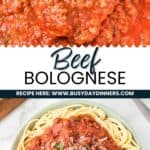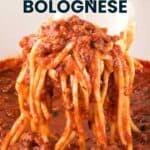Beef Bolognese
Beef Bolognese is a homemade, hearty pasta sauce that is quick to prep and incredibly delicious. This rich and meaty sauce is the best choice for a satisfying weeknight family dinner, providing an easy and flavorful experience that will leave everyone asking for seconds.

Spaghetti Bolognese is a classic and beloved Italian dish that has won the hearts of many food enthusiasts worldwide. Originating from the Italian city of Bologna, this rich and flavorful meat sauce combines the perfect balance of ground beef, aromatic vegetables, and delicate herbs. Paired with pasta, this easy recipe creates a mouthwatering meal that will impress anyone, even the pickiest of eaters.
You may wonder why this meaty pasta sauce stands out from other meat sauces. The key lies in its preparation and unique combination of ingredients. A traditional bolognese sauce is made using a blend of ground beef, finely chopped vegetables like onions, celery, carrots, and a touch of tomato. Authentic Bolognese sauce is then simmered with milk, which adds depth and creaminess to the dish, setting it apart from your typical tomato-based meat sauce.
Why You’ll Love Beef Bolognese
- Flavorful and Hearty: Combining ground beef, vegetables, and aromatic herbs creates a rich and satisfying sauce you can’t resist. This hearty dish is perfect for family dinners, potlucks, and special occasions.
- Easy to Make: This Beef Bolognese sauce recipe is surprisingly simple. Most of the ingredients are pantry staples, and once it’s simmering on your stove, it does most of the work while filling your kitchen with wonderful aromas.
- Adaptable: While many Bolognese sauces use a mixture of ground meats, you can easily use only ground beef if that’s what you have. You can also experiment with different types of pasta or even try it over a bed of cooked vegetables or zucchini noodles for a lighter option.
- Comfort Food at Its Finest: There’s just something about a warm bowl of pasta topped with Beef Bolognese that hits the spot, making it the epitome of comfort food. You’ll look forward to every bite you take, as it oozes coziness and satisfaction.
- Great for Meal Planning: This delicious bolognese sauce is perfect for meal prepping, as you can easily make a large batch and freeze portions for later use. This way, you’ll have a tasty and stress-free dinner ready in no time when you’re in a pinch.
Ingredients
- Extra virgin olive oil: This oil will be used to sauté the onion and garlic, giving them a silky texture and enhancing their flavors.
- Yellow onion: The chopped onion adds a zesty and aromatic base to the sauce.
- Garlic: The minced garlic gives the recipe a lovely hint of pungency and depth.
- Ground beef: The ground beef serves as the main protein, adding a rich and meaty flavor and texture to the Bolognese.
- Crushed tomatoes: These tomatoes bring acidity, sweetness, and color to the sauce, helping to balance the flavors.
- Tomato paste: Tomato paste intensifies the tomato flavor and thickens the sauce, making it more robust.
- Italian seasoning: This blend of herbs brings a delightful layer of aromatic flavors to complement the richness of the beef.
- Dried parsley: Parsley adds a subtle touch of earthiness and lightness to the dish.
- Worcestershire sauce: Worcestershire sauce brings an umami taste and a touch of tanginess, enhancing the overall flavor profile.
- Ketchup: The ketchup adds sweetness and tomato flavor to round off the sauce.
- Salt: Salt is essential for seasoning and enhancing the other flavors.
- Black pepper: Pepper adds a gentle spiciness to the Bolognese, making it more complex and interesting.
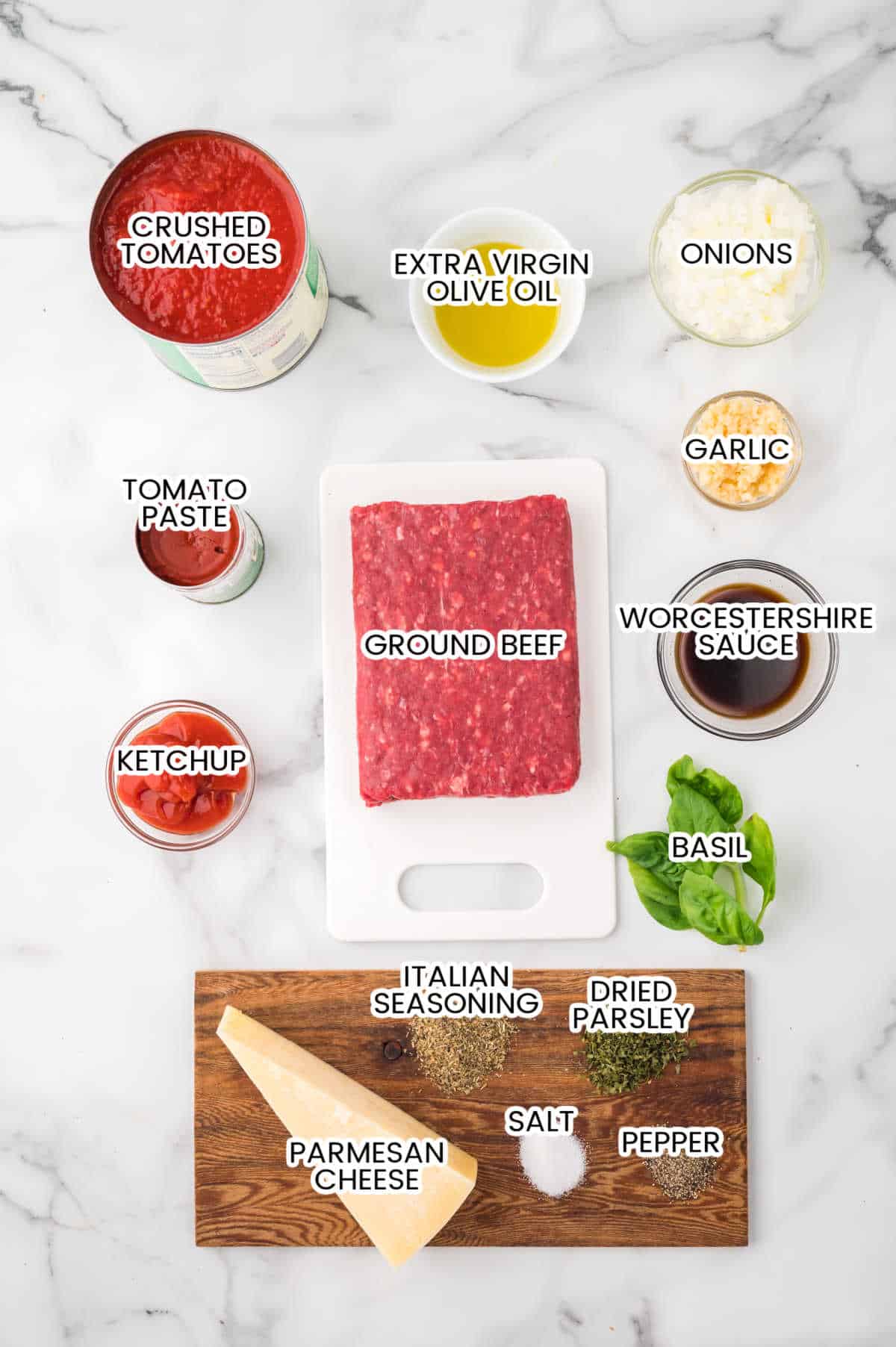
How to Make Beef Bolognese
- Step One: Heat the olive oil in a large pot over medium-high heat. Next, add the chopped onions and minced garlic to the pot, sautéing for 2 to 3 minutes until they soften.
- Step Two: Add the ground beef. Cook it for 10 minutes, breaking it up as it browns and cooks thoroughly. Once the beef is cooked, add the crushed tomatoes, tomato paste, Italian seasoning, dried parsley, Worcestershire sauce, ketchup, salt, and pepper. Stir the ingredients well to combine everything evenly.

- Step Three: Bring your mixture to a simmer, then reduce the heat to low and cover the pot with a lid. Allow the sauce to simmer for at least 1 ½ to 2 hours, stirring occasionally. You’ll know it’s ready when the sauce has thickened to your desired consistency.
- Step Four: When it’s time to serve, spoon the bolognese sauce over your favorite pasta or mix the cooked pasta directly into the pot, combining it with the sauce before plating. Finally, garnish your dish with fresh basil and grated Parmesan cheese for a delightful, friendly, and comforting meal.
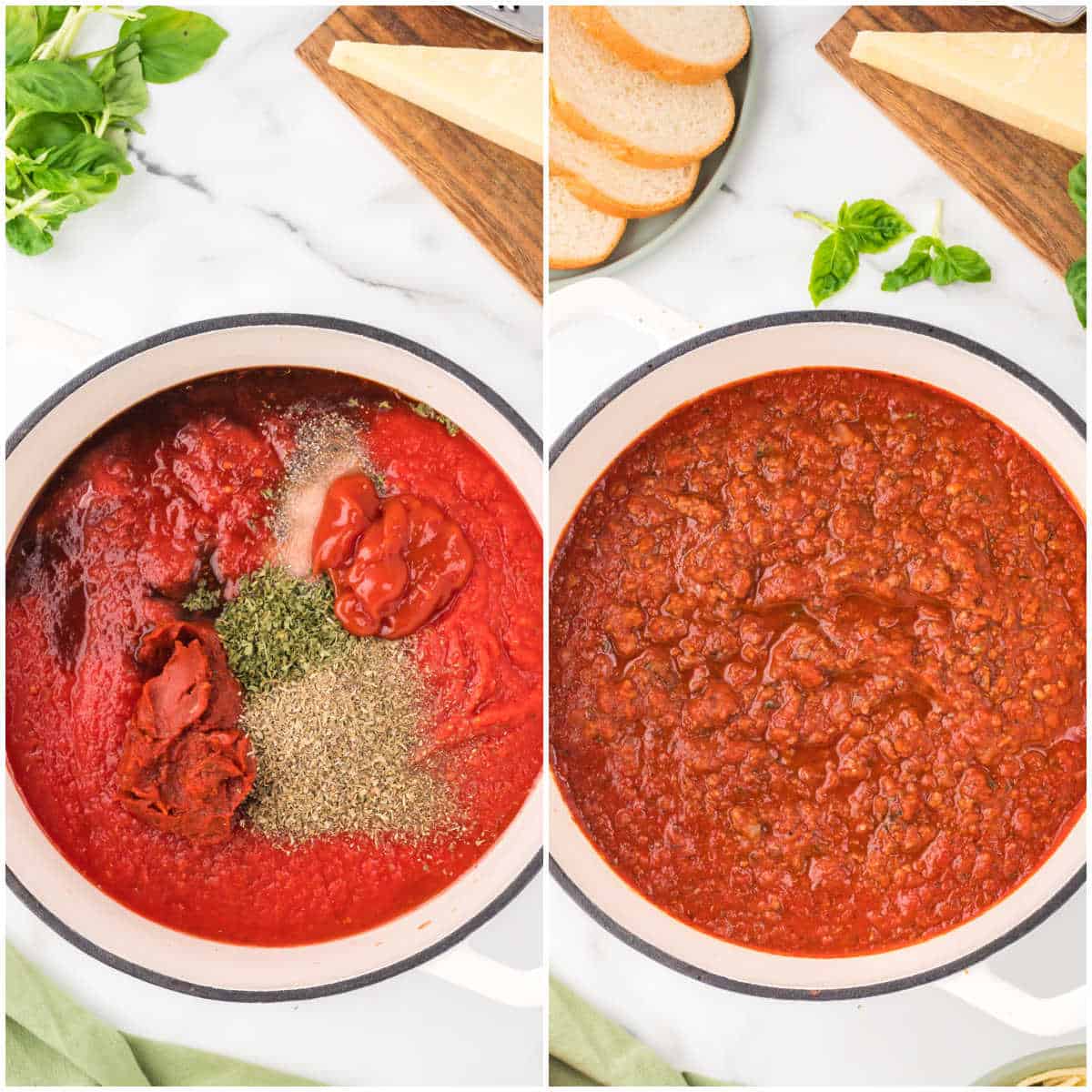
Equipment Needed
This post contains affiliate links for your convenience. As an Amazon Associate, we earn from qualifying purchases.
- Large heavy-bottomed pan or Dutch oven
- Sharp chef’s knife
- Cutting board
- Wooden spoon
- Spaghetti server
What to Serve with Beef Bolognese
- Garlic Bread, Crusty Bread, or Bruschetta: These options make a great appetizer and complement the flavors of bolognese beautifully. Garlic bread can be served alongside your pasta, while bruschetta is a nice choice if you prefer bread on the side to soak up the sauce source.
- Salads: A fresh, crisp Caesar salad can pair well with the rich flavors of bolognese. You can also serve a simple green salad with a light vinaigrette to provide a nice contrast and help balance the meal.
- Vegetables: Incorporating vegetable sides, such as braised mushrooms, garlic broccolini, or zucchini boats, adds color and nutritional value to your plate. Roasting or grilling vegetables brings out their natural sweetness and complements the bolognese sauce well.
- Starchy Sides: If you’re looking for something a bit more filling, consider adding sides like mac and cheese, mozzarella sticks, or polenta. They can provide an extra layer of comfort and satiation to your meal.

Variations and Substitutions
- Try different types of protein: Instead of using just ground beef, you can experiment with ground lamb, pork, turkey, or chicken. Mixing other proteins can add depth of flavor and richness to the sauce.
- Vegetarian or vegan options: For a vegetarian or vegan dish, you can replace the beef with lentils, mushrooms, tempeh, or a combination of plant-based protein sources.
- Add variety with vegetables: Some recipes include carrots and celery in the sauce for extra flavor and texture. Add other veggies like zucchini, bell peppers, or spinach to make the sauce more nutritious and colorful.
- Make it spicy: Add 1 to 2 teaspoons of red pepper flakes or a diced chili pepper.
- Make it creamy: Stir in 1/2 cup of heavy cream or milk at the end of the cooking time. Traditional Bolognese is made with milk.
- Swap out the Worcestershire sauce: Use soy sauce as a substitute in a pinch. It won’t have the same flavor, but it will add a savory depth to the sauce.
- Swap out the crushed tomatoes: Use cans of diced tomatoes instead. You may need to use an immersion blender to blend the sauce to make it smooth.
- Opt for fresh herbs: You can use fresh herbs instead of the dried herbs in this recipe. Use two tablespoons of fresh herbs for one tablespoon of dried herbs in the recipe.
- Switch out the tomato paste: Use tomato sauce instead, but you may need to simmer it longer to thicken it up.
Beef Bolognese Origins
Historical Background
Originating in the late 18th century, Beef Bolognese comes from Bologna, Italy, and is a ragù sauce. Ragù has regional variations throughout Italy, with Bolognese as one of them. The word “ragù” comes from the French word ragout, which refers to stews of meat and vegetables cooked over low heat for a long time. This delicious sauce has multiple possible birthplaces, including Rome, Naples, or Imola, where regional versions of ragù converged over time.
Italian Tradition
In Italy, Beef Bolognese is known as ragù alla bolognese or simply ragù, and it has its roots in Bologna. It is commonly used as a sauce with tagliatelle, a traditional pasta from the Emilia-Romagna and Marche regions, and to prepare ‘lasagne alla bolognese.’ This meat-based sauce typically contains tomatoes, ground meat, cream, and herbs, creating a hearty meal that fills your house with its exquisite aroma for hours.
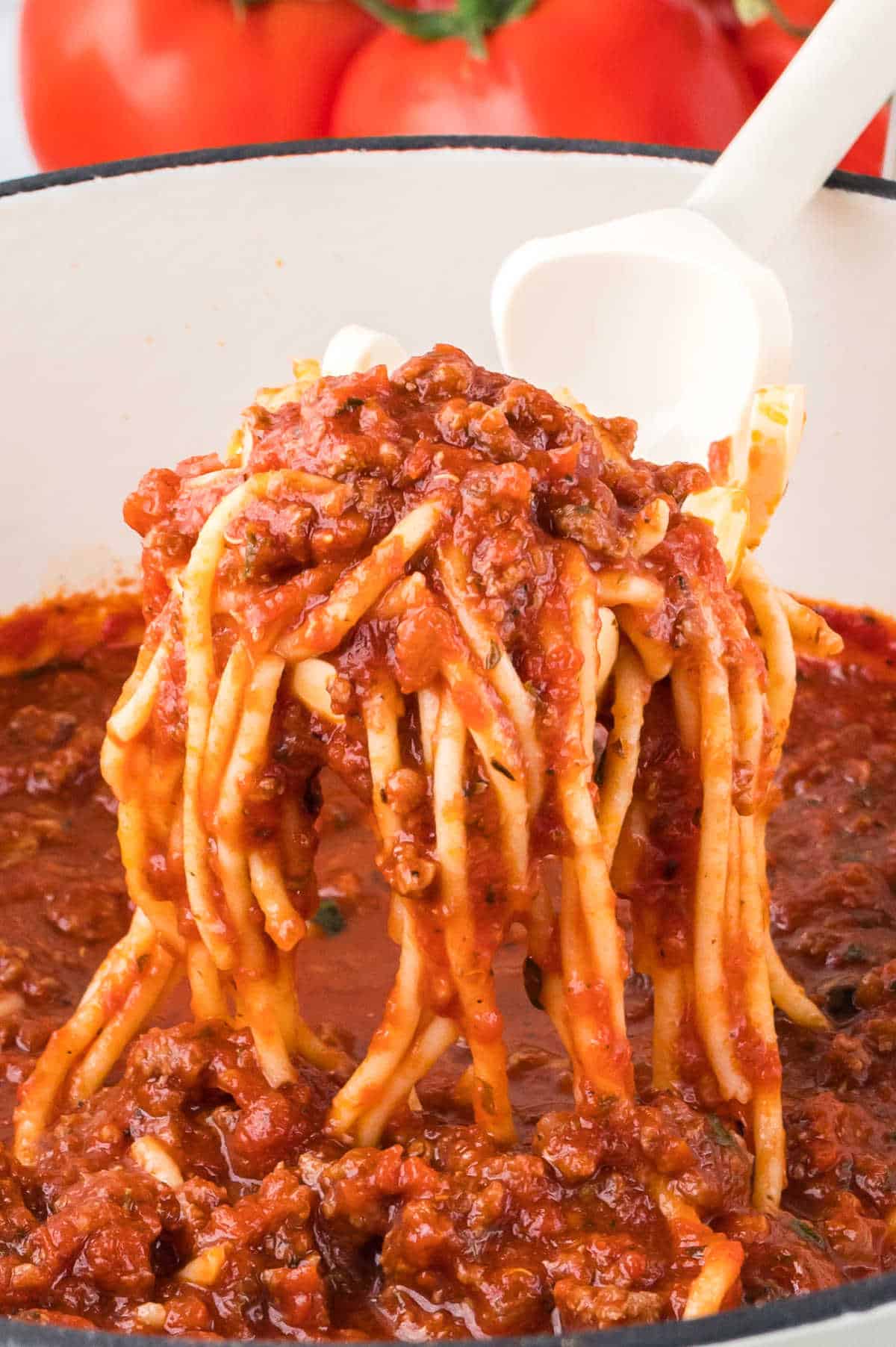
Toppings and Accompaniments
When enjoying a delicious beef bolognese, the right toppings and accompaniments can make all the difference.
Pasta Choices
Many types of pasta pair well with beef bolognese sauce, but here are three popular options to consider:
- Spaghetti: A classic choice, spaghetti is long and thin, allowing the bolognese sauce to cling to it satisfyingly. It’s an ideal choice for a traditional bolognese serving.
- Tagliatelle: This wide, flat noodle offers a more substantial bite and easily holds onto the hearty meat sauce. It’s a wonderful option for those looking for more texture in their bolognese dish.
- Rigatoni: With its tube-like shape and ridges, rigatoni creates pockets for the sauce, ensuring each mouthful is flavorful. For those looking to try something different, rigatoni is an excellent choice.
Cheese Options
Adding cheese to your beef bolognese can bring a whole new flavor to your dish. Here are a few popular options:
- Parmesan: This hard, slightly salty cheese is a classic choice for topping bolognese. Grating fresh Parmesan over your dish adds a delectable umami note that perfectly complements the rich sauce.
- Pecorino Romano: An Italian sheep’s milk cheese, Pecorino Romano has a strong and tangy flavor. It is another excellent choice for enhancing the taste of your bolognese sauce.
- Ricotta: If you want a creamier addition to your beef bolognese, try adding a dollop of ricotta cheese. Its mild and slightly sweet flavor pairs well with the savory meat sauce, creating a delightful contrast in your dish.
Beef Bolognese Variations
Regional Styles
In Italy, you may find that different regions have their unique take on the classic beef bolognese sauce. The original ragù alla Bolognese, as it is called, comes from Bologna and typically includes beef/pork-based sauce cooked with a base of carrots, celery, and onions. Some other regional styles might use different types of meat or additional ingredients such as pancetta, red wine, or even milk.
Going with imported Italian Roma tomatoes, like San Marzano, is recommended when choosing tomatoes for your bolognese sauce.. This will ensure an authentic flavor in your dish. You can also experiment with different types of pasta, like fettuccine, pappardelle, or tagliatelle, to suit your taste.
Dietary Adaptations
If you’re cooking for someone with special dietary needs or restrictions, there are many ways to adapt the traditional beef bolognese recipe. For example, if you need a vegetarian or vegan option, you can replace ground beef with a plant-based alternative, such as lentils or a meat substitute.
For lactose intolerant, substituting regular milk with a dairy-free alternative like almond, soy, or oat milk is easy to tweak the recipe. You can also make your bolognese gluten-free by using rice or chickpea pasta instead of the traditional wheat-based pasta, ensuring everyone can enjoy your delicious creation.

Storage and Reheating
Proper Storage
Storing your beef bolognese correctly can greatly extend its shelf life and maintain its delicious taste. After letting it cool to room temperature, transfer your bolognese to an airtight container before placing it in the fridge. This method keeps your bolognese fresh for up to 3-4 days.
Reheating Tips
Reheating your beef bolognese is easy and can taste just as delicious as when you first made it. There are a few methods you can try:
Oven: Preheat your oven to 350 degrees Fahrenheit. Place your bolognese in an oven-safe dish, ideally a glass one. Cover your dish snugly with aluminum foil to retain moisture. Bake the bolognese for approximately 20-30 minutes until heated. Be sure to check and stir occasionally for even heat distribution.
Stovetop: Gently melt some butter in a pot or pan on medium-low heat. Add your bolognese and a tablespoon or two of liquid, such as milk, water, or beef broth, to help rehydrate the sauce. Warm up your bolognese on the stovetop while stirring occasionally to ensure even heat distribution. Once it’s thoroughly heated, you’re ready to serve.
Microwave: If you’re in a hurry, the microwave is convenient. Transfer your bolognese to a microwave-safe dish and cover it with a lid or cover. Use the reheat setting for about a minute for effective reheating, then stir. Increase the heat to high and microwave at 15-second intervals till the bolognese reaches an internal temperature of 165 degrees Fahrenheit or 74 degrees Celsius.
Can I Freeze?
Yes, you can freeze your beef Bolognese sauce! Freezing Bolognese sauce is an excellent way to save time and have a ready-made meal in your freezer for those busy days. Not only does it preserve the sauce, but it also maintains its taste and texture.
Before freezing, make sure the sauce has cooled down completely. Transferring the Bolognese sauce to an airtight container or a freezer-safe bag is best. This helps preserve the flavor and prevent freezer burn. If you’re using a bag, lay it flat and remove as much air as possible before sealing. This technique also makes it easier to stack bags in the freezer, saving space.
When storing Bolognese sauce in the freezer, it’s a good idea to label each container with the date you froze it. This way, you’ll easily track how long your sauce has been in the freezer. Bolognese sauce can last up to 3 months in the freezer, ensuring you always have a delicious meal option.
Place the container or bag in the refrigerator for several hours or overnight to thaw your Bolognese sauce. Thawing it in the fridge helps the sauce keep its texture and flavor. You can also use a microwave to defrost it if you’re short on time, but use a microwave-safe container and stir the sauce occasionally to ensure even heating.
Once your sauce is thawed, reheat it in a saucepan over low heat and stir occasionally. If the sauce appears too thick, you can add a little water. It’s ready to be served with your favorite pasta when it’s heated through.
How to Make Thicker
Making a thick sauce is key to achieving that rich, hearty flavor that everyone loves. To create a more satisfying texture, try the following tips in your cooking process.
First, cook your sauce at a low simmer for an extended period. This slow process makes the sauce thicken naturally as the liquid evaporates and flavors concentrate. Be patient and let your bolognese develop its richness over time; it might take a couple of hours, but the result will be worth the wait.
Second, consider adding a touch of milk to your sauce, making it thicker and bringing a creaminess to the dish. The inclusion of milk might surprise you, but it complements the other ingredients and helps meld all the flavors together. Start with a small amount and adjust to your liking.
In addition to cooking time and milk, the choice of ingredients can significantly affect the thickness of your sauce. Opt for ground beef with higher fat content, such as a 20% fat beef chuck. The higher fat content will contribute to your bolognese’s overall thickness and flavor.
Lastly, don’t forget the power of a good pasta choice. While it may not directly affect the thickness of your sauce, choosing pasta with grooves or ridges, such as tagliatelle or pappardelle, helps the sauce cling better to the pasta, creating a more satisfying and cohesive dish.
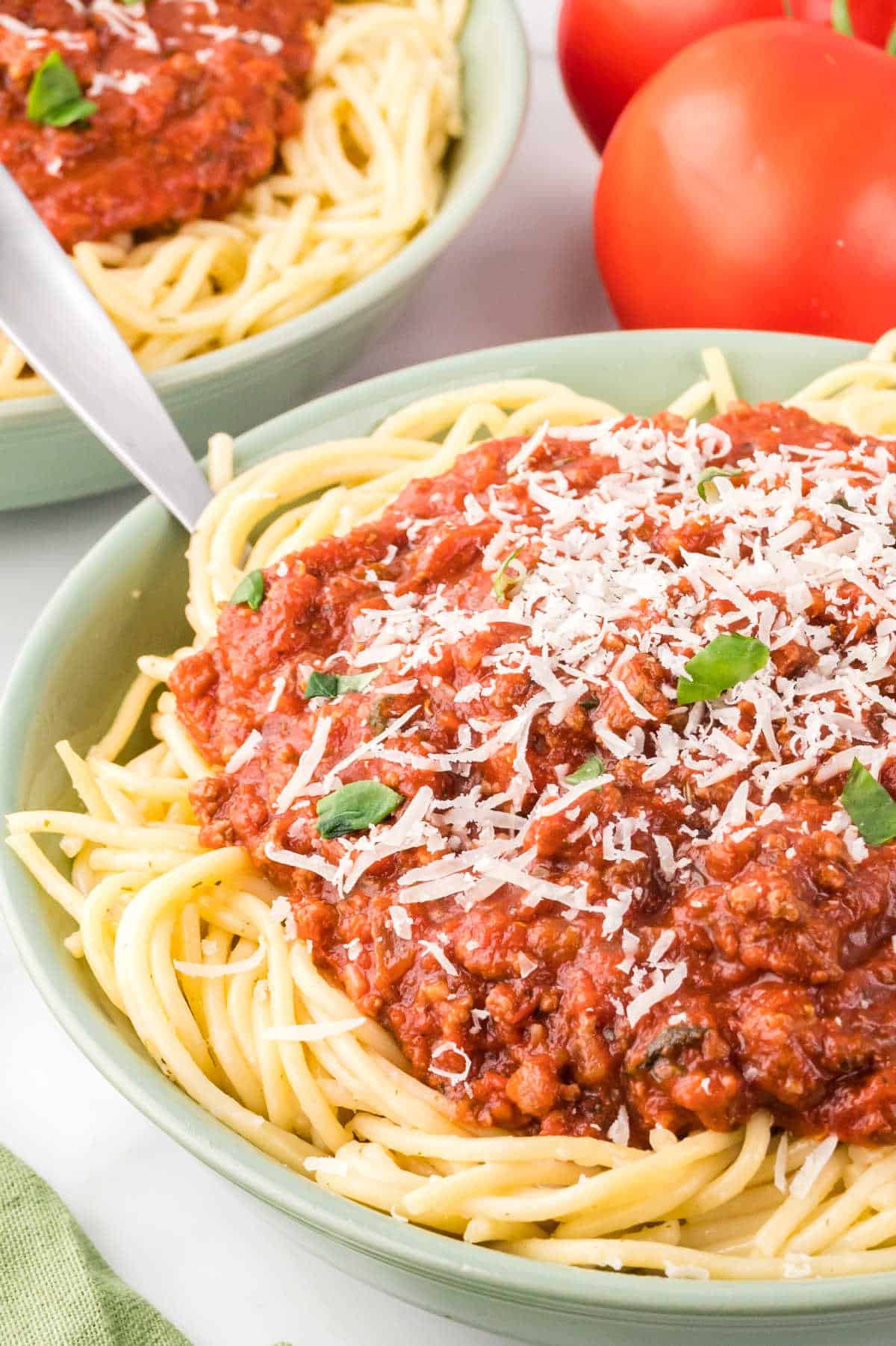
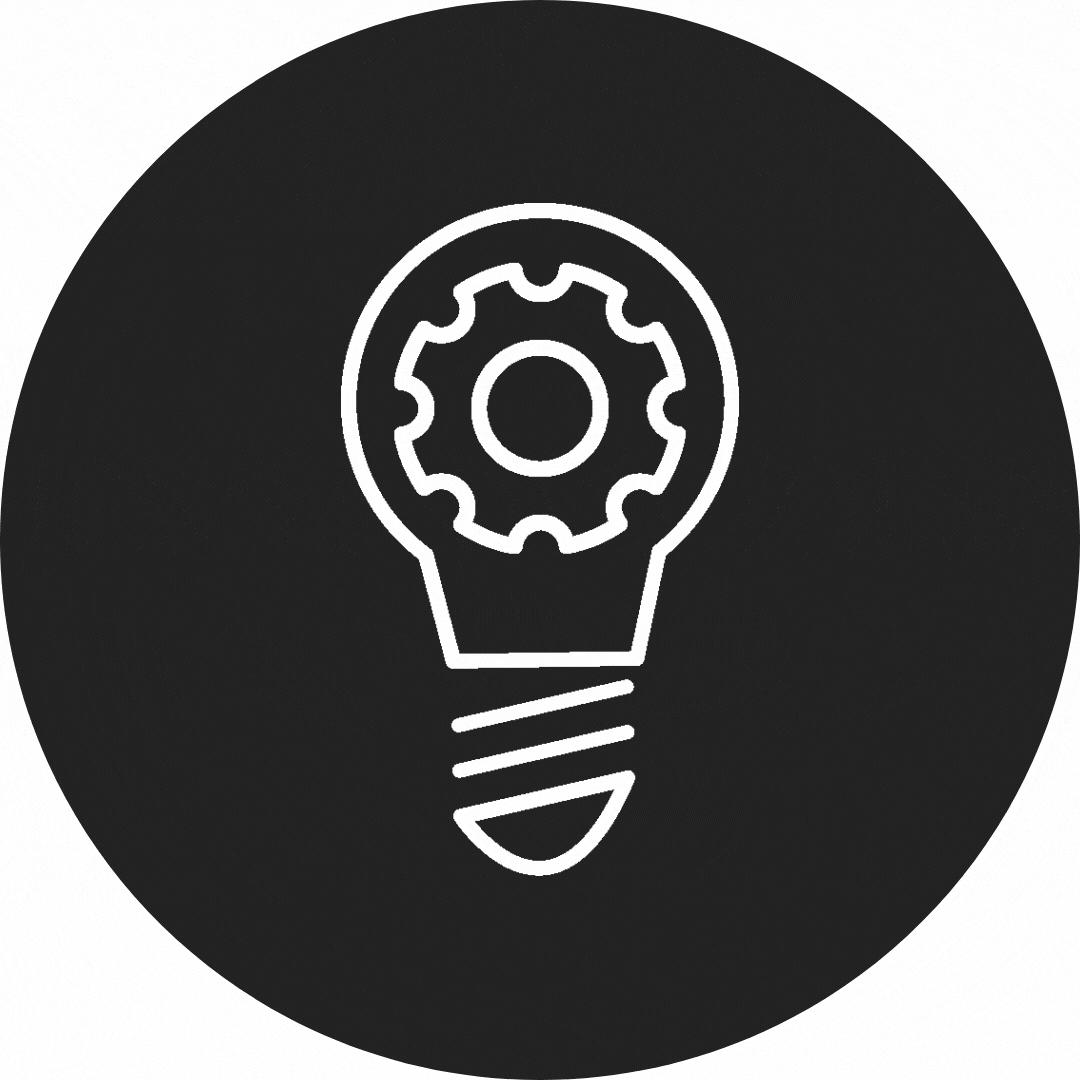
FAQs
Our Favorite
Pasta Recipes

JOIN OUR EMAIL LIST &
Get Your Free Weeknight Dinner Recipes eBook
Beef Bolognese
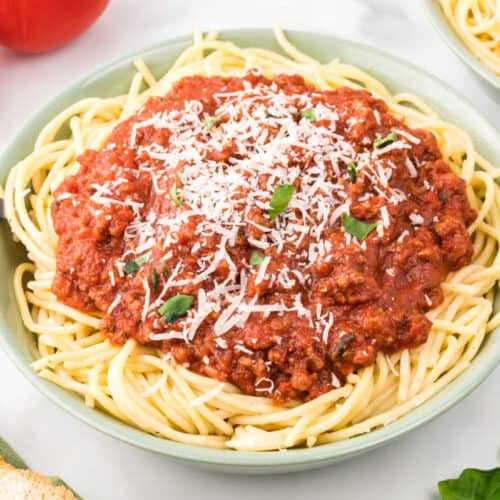
Equipment
Ingredients
- 2 tbsp extra virgin olive oil
- 1 large yellow onion chopped
- 4 cloves garlic minced
- 2 lb ground beef
- 2 cans crushed tomatoes 28oz cans
- 1 can tomato paste 6oz can
- 2 tbsp Italian seasoning
- 1 tbsp dried parsley
- 2 tbsp Worcestershire sauce
- 4 tbsp ketchup
- 1 tsp salt
- 1 tsp pepper
Instructions
- Heat the olive oil in a large pot over medium-high heat.
- Add the chopped onions and minced garlic and saute for 2 to 3 minutes until they are starting to soften.
- Add the ground beef to the pot and cook for about 10 minutes, breaking it up until it's browned and cooked.
- Add the crushed tomatoes, tomato paste, Italian seasoning, dried parsley, Worcestershire sauce, ketchup, salt and pepper. Stir well to combine.
- Bring the mixture to a simmer, then reduce the heat to low and cover the pot with a lid.
- Let the sauce simmer for at least 1 ½ to 2 hours, stirring occasionally, until the sauce has thickened.
- Serve the bolognese sauce over your favorite pasta or place cooked pasta into the pot and combine it with sauce before serving.
- Garnish with fresh basil and grated Parmesan cheese.

